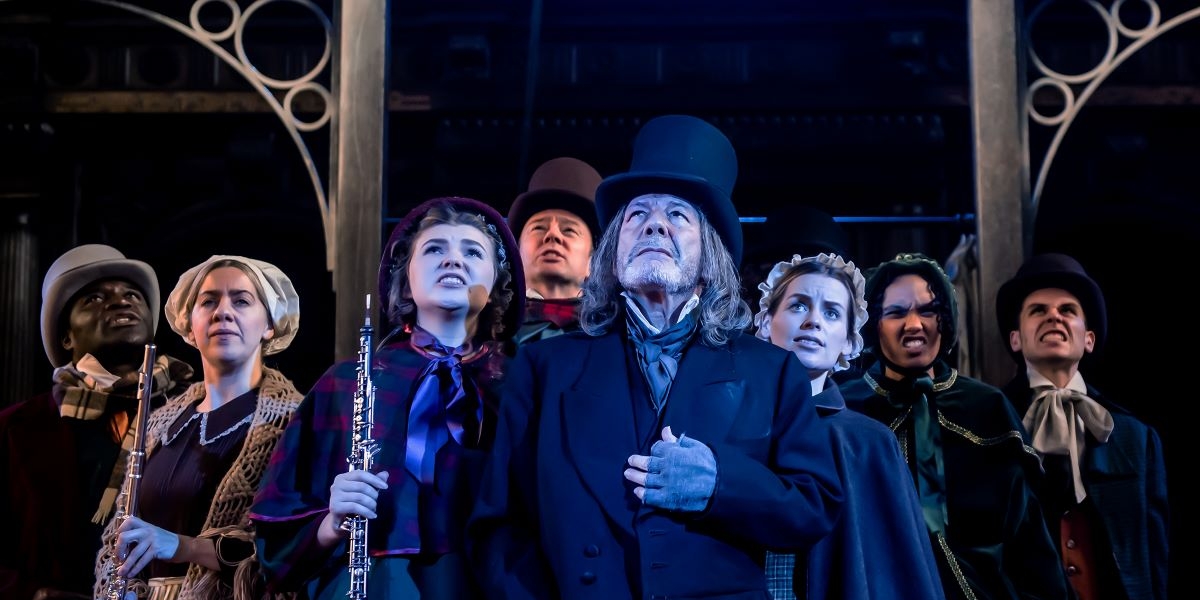Antic Disposition have gained a distinguished reputation for their adaptation of Dickens’ ‘A Christmas Carol’, performed now for a decade or more at Middle Temple Hall in the City of London. I had the opportunity to review the show five or so years ago, and was eager to see how it has changed and developed in the interim. I am happy to report that the same combination of winning qualities shine through as before, though the show has evolved into much more of a musical along the way.
I have seen many versions of this classic tale over the years, and this experience leads me to conclude that two aspects are crucial above all to overall success. Firstly, and perhaps more obviously, the special effects of spectral incursions and journeys back and forth in time need to convince, though that does not mean they have to be spectacular in a crude sense. Secondly, we need to feel the pinch of poverty and deprivation in vivid terms before the oversized turkey and plum pudding are wheeled on. Without the latter then easy Victorian sentimentality beckons which is the instant death of the drama.
Directors Ben Horslen and John Riseboro are sensitive to both these issues. They use the atmoshere of the venue (one familiar to Dickens himself) to very good effect. The set, lighting, and sound designs are meticulously evocative with a more or less continuous underscore in the manner of Victorian melodrama, and swift scene changes achieved mostly by the cast themselves. Blackouts are long enough to allow the imagination to do its work. Settings are economically suggested by part for the whole, as in the case of Scrooge’s armchair, enough to indicate his diminished, austere lodgings. But there is more than enough sensual ‘joie de vivre’ when we need it, whether in exuberant period costume or festive decorations and fodder.
The task of depicting poverty of pocket and soul and its consequences lies primarily with the cast who are uniformly excellent whether in individual performance or ensemble integration. Leading the way is David Burt as Scrooge, who is surely right not to melt into recognisable humanity too soon. He makes us feel the selfish results of his closing down of human empathy so that when he does open himself up to a world of remorse and recompense it is all the more moving and credible. Key to this process are ghosts of Jacob Marley and the Christmases Past, Present and Future. Here Richard Holt is excellent in suggesting Marley’s grim aspect (a nice touch having him have to continually close his jaw by hand) and fearful urgency. And Gabriel Akamo is also outstanding both in exuberant joviality and getting us to savour the joys and pains of the Christmas Present.
Unalloyed goodness is always hard to play, so great credit goes to the actors depicting Bob Cratchit and his family. Pete Collis is the moral compass of much of the action outside the fantasy episodes, and Emma Manton as his wife is excellent too in reminding us of the real-life consequences of Scrooge’s selfishness. A special word should also go to Henry Beale who invested Tiny Tim with plausible dignity and charm and delivered the setting of the song at the centre of the action with complete confidence.
Mention of the music takes us to the heart of the success of this most recent incarnation of the show. Composer Nick Barstow has rearranged many of our familiar carols, now fitted out with fresh texts, so that there is a more or less continuous musical mood commentary on each stage of the action. There is a fierce rendition too of the ‘Dies Irae’ that makes a fitting climax. The four-piece band situated behind the action are highly expert. and four of the actors add extra instrumental lines of their own providing a dense or precise set of textures as needed. Timothy Mylechreest is particularly notable here for his fine trumpet solos, on top of his sterling portrayal of Scrooge’s much-put-upon nephew, Fred, and other minor roles.
There is sadly insufficient space here to describe all the excellent character-studies delivered by this fine cast, but the attention to detail is remarkable. This brings me to my one small caveat. With three blocks of audience seating to address at any one time, it is hard for any cast to be audible at all points, and a degree of microphone enhancement is desirable, particularly in the crowd or choreographed sequences, if we are to appreciate the skill of all the performers equally.
However, this does not detract from a production that continues to be a leader in the field not least through the directors’ determination not to rest on their laurels.

